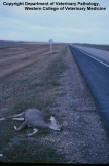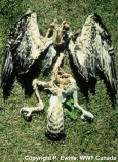|
|
| |
| Risk Factor |
-
Injuries or death resulting from a violent force that results in
compression, stretching, twisting or penetration of tissues.
-
Most common injuries or mortalities are from collisions with vehicles,
trains, aircraft, power lines or transmission towers.
-
Other
traumatic injuries and deaths also
include wounds received through trapping or shooting, fighting with
members of the same species, or wounds resulting from predators.
|
| Images |
|
Click on
images to enlarge. |
 |
 |
|
Deer and other mammals are
often struck by vehicles and may succumb to their injuries. |
Breast musculature is often
completely removed on depredated birds. |
|
| Distribution |
|
|
| Mechanism of Action |
-
The extent and severity of
traumatic wounds will depend on the
area of the body involved, the tissues damaged, as well as
the strength of the physical blow.
-
Secondary
bacterial infections may occur at
wound sites.
-
Internal injuries may be
severe or fatal, particularly if they result in organ
rupture.
|
|
| Signs and Symptoms |
-
Collisions with
vehicles are often fatal, although some animals can survive.
-
Victims of vehicle
collisions are often found on or near roadways. Injuries may not be
apparent as wounds may not be visible.
-
Shooting wounds may be
fatal, although fragments of ammunition may become lodged in bone
or, rarely, in tissue and become essentially inert.
-
Within-species
fighting injuries are rarely fatal or serious. Gore wounds may occur
in species with horns or antlers, while bite wounds on the neck and
throat may be observed in wild dogs. Secondary infections or organ
or body cavity penetrations/ruptures may cause illness or death days
or weeks after the original injury.
-
Injuries resulting
from predator attacks may be found on the hind legs, neck, head and
flanks.
Hemorrhage underneath the skin at the site of the wound is common
and may extend beyond the range of the wound itself.
-
Any animal with a pre-existing injury may be more
susceptible to a predator.
-
Predators may receive wounds from large game defending
themselves, e.g., head wounds or broken bones resulting from antler
or kicking blows.
-
Birds that have collided with power lines are often
found beneath either power lines or transmission towers. See also
electrocution.
|
| Meat Edible? |
-
Unless another
condition is present, meat from animals succumbing to
traumatic injury is safe for human consumption.
-
Any
traumatic injury will, however, likely reduce the quality of
meat.
|
| Samples for Diagnosis |
-
A full post-mortem
will identify the cause of death of most traumatic mortalities.
Portions of affected tissue can also be submitted.
|
| Similar Diseases |
-
A bird that is found
dead beside or near power poles or power lines cannot immediately be
assumed to have succumbed to
traumatic collisions with power lines, as
electrocution may also have occurred.
|
| Further Reading |
-
Alaska Department of Fish and Game – Trauma
-
Cooper J.E. 1996. Physical injury. Pp. 157-172 in A. Fairbrother, L.N.
Locke, G.L. Hoff (eds.),
Non-infectious Diseases of Wildlife. Iowa State University
Press. Ames, Iowa. 219 pp.
-
Elkin B., Zamke R.L. 2001. Common
Wildlife Diseases and Parasites in Alaska. Alaska Department of
Fish and Game. Anchorage, AK.
|
|
|

